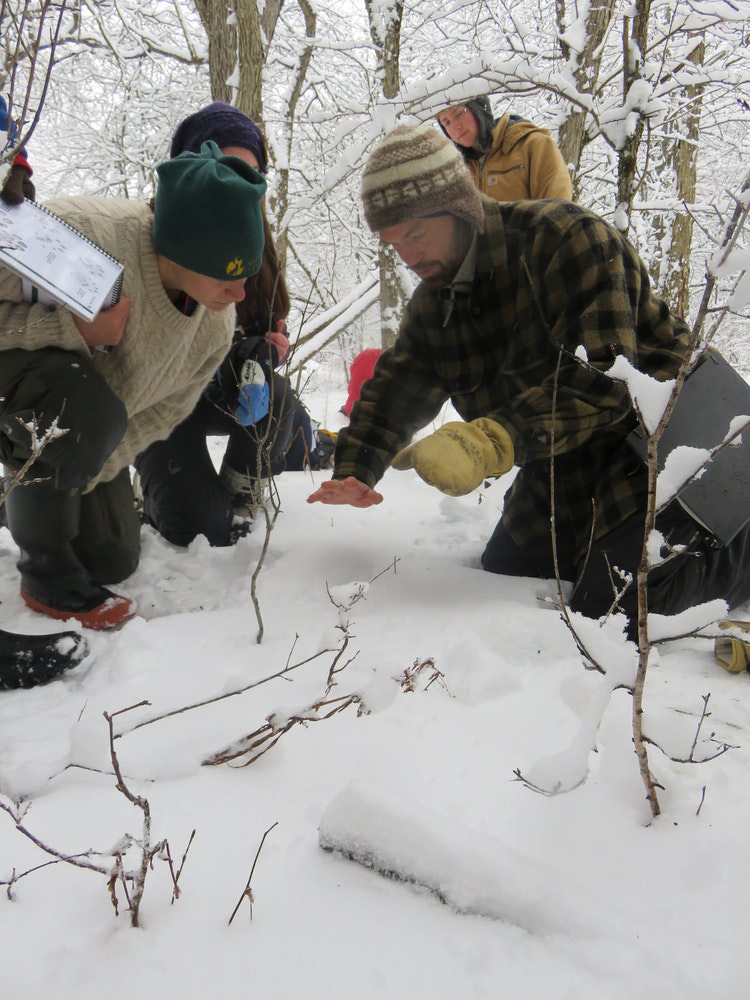Tiffany Cheezem
Our Wilderness Year group has been together since September, and we’ve done many things together: we’ve made clay bowls and wooden bows; tanned hides and collected acorns rich in tannins we’ll have to leach out before we eat them; we’ve slept out in debris shelters and cooked on rocks; and we’ve made many, many friction fires.
One thing we hadn’t done until recently, though – one thing I’d been itching to do since day one – was track animals. But mid-January was the appointed time, and so by Jove we went out in mid-January to look for animal tracks.
Well.
The first week of our tracking module was met with a perfect storm, if you will, of weather conditions antagonistic to tracking. If there’s snow on the ground, it’s easy to see tracks just about everywhere. If it’s too warm for snow, usually you can find good tracks in mud. But the elements conspired to make it warm enough to rain instead of snow – which also washes away tracks in soil and mud – and cold enough that most mud was frozen from about 2 millimeters down.
And yet – due no doubt to our fearless leaders’ experience and knowledge of “the good spots” – we saw no shortage of different species. It was usually only a few prints at a time, but we were lucky to see red and gray squirrel; raccoon; opossum; muskrat; red and gray fox; coyote; otter sign (scat and scent markings); deer; and many others I am doubtless forgetting.
We also spent some time that week learning from inside a classroom – unusual for us, but not unwelcome in that weather. We looked at animal feet and skulls; made impressions in clay; and learned about different ways to narrow down the universe of possibilities that is presented to you whenever you see a track.
The second week, however, was an entirely different story. It was as if the universe recognized the groundwork we had laid the first week, and approved. It sent us a fresh blanket of snow, and did it ever send us animals upon it.
On the second day of the second week, we travelled to Shindagin, and that is where the story of our most epic day of tracking begins:
Our group arrived at the trailhead in bits and pieces, one small group or single person at a time. It so happened that we intersected with an individual who had just been walking their dog down along the creek and acted nervous when we expressed interest in looking at their dog’s tracks.
We found their “ecologically incorrect” sign later. Funny.
In among the pine trees off the trail we found tracks of squirrels, mice, rabbits, birds (jays? I can’t remember) and deer in the woods.
In a field, we played in the snow, laying out colored squares representing front and hind feet in patterns representing different animal gaits.
We tried to emulate those gaits ourselves. (Have you ever tried a side trot? How about a bound. It has been said, you haven’t lived till you’ve seen a good Sean Cornell bound.)
We walked just a little further and down towards the creek. And there we saw very, very fresh tracks.
The tracks of a mammal. (What family?)
The tracks of a mammal with five toes on both feet. (Weasel family?)
The tracks of a swiftly moving mammal with five toes on each of four rather large (almost palm-sized??) feet. (A large weasel?)
The tracks of a mammal with relatively large feet, five toes, and claws showing, moving in a 3×4 lope along the creek.
We figured it could only be one thing: the elusive and energetic fisher.Jed, to the group: “How old are these? When did this animal move through here?”
Jesse: “Pretty darn fresh – “

